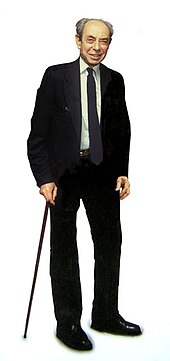Frank Oppenheimer
Frank Friedman Oppenheimer (born August 14, 1912 in New York City , † February 3, 1985 in Sausalito , California ) was an American physicist .
Life
Frank Oppenheimer was the eight years younger brother of the famous theoretical physicist J. Robert Oppenheimer , the first director of the Los Alamos National Laboratory and an important contributor to the Manhattan Project .
Oppenheimer, who once considered becoming a flautist in his youth, studied physics at Johns Hopkins University . After completing his bachelor's degree in 1933, he went to the Cavendish Laboratory at Cambridge University for a year and a half, and in 1935 worked at the Institute di Arcetri in Florence , where he worked on particle counters in nuclear physics.
He received his doctorate from Caltech and was involved in the Manhattan Project during World War II, first at the University of California Radiation Laboratory under Ernest O. Lawrence , where he worked on the isotope separation of uranium isotopes and oversaw the operation of the first uranium enrichment plant in Oak Ridge . He then worked in Los Alamos , where he supervised safety precautions in the Trinity test of a nuclear weapon under his brother . After the war he went to Berkeley , where he worked with Luis Walter Alvarez and Wolfgang Panofsky to build the linear accelerator for protons. In 1947 he became an assistant professor at the University of Minnesota .
His career was cut short in the McCarthy era when it became known that he was a former Communist Party member , which he had joined after his marriage to his wife in 1936 (against his brother's advice). Before the McCarthy committee , he refused to reveal the names of other members. He had to give up his university post and found no other job as a physicist. As he later learned, the FBI was sending warning letters to institutions to which he was applying at the time. In addition, he was denied the opportunity to work abroad because he was not issued a passport . Eventually he sold one of the Van Gogh paintings he had inherited and used the proceeds to buy a cattle ranch in Pagosa Springs , Colorado .
In the late 1950s, he began teaching at a high school and then at the University of Colorado , where he eventually became interested in physics didactics . With a grant, he developed laboratory experiments for school ( Library of Experiments with around 100 experiments). With a Guggenheim Fellowship he worked in 1965 at the University College in London to bubble chamber to conduct experiments and history of physics to investigate. Inspired by the science museums of Europe, he developed the concept of an interactive science museum, which he implemented in 1969 in the form of the Exploratorium in San Francisco and of which he was director until his death. In 1983 he became a Fellow of the American Association for the Advancement of Science .
Web links
Individual evidence
- ^ Fellows of the AAAS: Frank Oppenheimer. American Association for the Advancement of Science, accessed July 28, 2018 .
| personal data | |
|---|---|
| SURNAME | Oppenheimer, Frank |
| ALTERNATIVE NAMES | Oppenheimer, Frank Friedman |
| BRIEF DESCRIPTION | American physicist who worked on the Manhattan Project |
| DATE OF BIRTH | August 14, 1912 |
| PLACE OF BIRTH | New York City |
| DATE OF DEATH | 3rd February 1985 |
| Place of death | Sausalito (California) |
